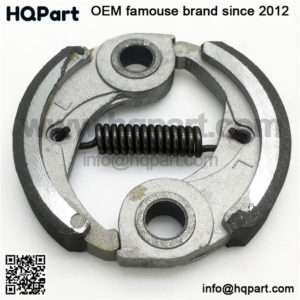There are so many videos and articles comparing torque converters and clutches for Go-Karts (in fact we have one too). But very few compare these two transmission systems for mini-bikes.
Let me begin by first telling you, Clutches and Torque converters are not at all same. They both use centrifugal force to engage and disengage, but that’s about it in terms of similarities.
They work very differently and are useful for different purposes, both have their own advantages and disadvantages.
Key Differences
| Torque Converter/CVT | Centrifugal Clutch | |
| Gear Ratios | Infinite | Fixed |
| Power loss | High | Low in comparison |
| Launch | Very Good | Poor |
| Drive Type | Belt and Chain type both | Chain type |
Gear Ratio: For a mini-bike, we can define the gear ratio as the ratio between the angular speed (rpm) of the engine’s shaft and the angular speed (rpm) of the rear wheel.
Power Loss: Most mini-bike engines can produce 6.5hp power but not all the power reaches the wheel. Some power is lost during transmission, the loss is high in Torque Converter in comparison to Clutch.
Launch: By launch we mean the acceleration of the mini-bike when just starting. You can also think of it as the torque your wheels receive when just starting.
Drive Type: By drive type we mean, whether the mini-bike uses a chain or belt to carry power from the engine to the wheel.
Does a torque converter make a mini bike faster?
At first glance, you might think that the torque converter will make your go-kart slower since there is more power loss. But it is a little more complicated than that.
Mini Bikes with Torque Converters are faster than Mini-Bikes with Clutches.
Speed mainly depends on 4 factors, Gear Ratio, Engine’s RPM, Power lost in transmission, and wheel size. (There are other factors such as weight of driver, road, etc that will have a small impact).
You can use our calculator below to roughly estimate the top speed of your Mini-Bike (Note: This calculator does not take into account Power Loss)
Mini Bikes usually use 19″ tires. If a clutch is used along with a 19″ tire, we will have to maintain a gear ratio of 10:1, which is usually how they come from the factory.
A torque converter on the other hand can have a gear ratio of 6:1 at the high end. That is a huge advantage in comparison to Clutches.
Therefore, even though the power lost in the torque converter is more, the gearing makes up for it.
You might be wondering, why can’t you just gear higher with a clutch?
Low gearing provides your minibike with high torque that is required to carry those 19″ tires. If you were to use a higher gearing with a clutch, your clutch will burn after 2-3 uses.
Torque converters work in such a way that they will have low gearing when your mini-bike is just starting (as low as 20:1) and have high gearing at high speeds.
Which is better Clutch or Torque Converter?
This is hard to answer and will depend on your wants and budget etc.
Clutches are cheap and are more efficient, torque converters are expensive but have variable gearing which is very useful on mini-bikes.
Torque converters are especially very useful for hill climbing or any road that requires a lot of start-stop situations.
Installing a Torque Converter can be a frustrating and time-consuming task, you might even need to do some machine work on your mini-bike.
There isn’t a clear winner between the two, both have their own use case, having said that, the majority of people prefer Torque converters over clutches (in our observation).
How Do they work?
You might be wondering how different they are in terms of working, maybe it can make your decision easier if you know how they work.
Clutch
The working mechanism of the Centrifugal Clutch isn’t complicated, when the engine is idling, the clutch isn’t engaged and your mini-bike stays where it is.
As you open the throttle, the engine’s crankshaft starts rotating faster, as a result, the internal parts of the clutch start to rotate faster and due to centrifugal force the internal and external part of the clutch engages, making the chain move and the wheels move.
Exactly how the internal parts engage and disengage is too lengthy to cover here, you can read more about it in our article about how centrifugal clutches work.
Torque Converters
Torque converters/CVTs are much more complicated in how they work. They have more parts in comparison.
To give a brief summary of how they work, the torque converter has 2 pulleys. A driver pulley, and a driven pulley, and a belt in between the 2 pulleys.
The gear ratio depends on the ratio between the active diameter of the 2 pulleys, as the engine’s speed increases, the gear ratio decreases, and vice versa.
It is a very interesting system, but we cannot cover it entirely here, you can check our “how a torque converter works” article.
Compatibility
It is very important to know that a lot of mini-bikes come with a 5/8″ crankshaft instead of the 3/4″. Most of the clutches and Torque converters on the market are for 3/4″ shafts.
You need to first measure your minibike’s shaft diameter (by tape) and make sure to order a Torque converter or Clutch that is compatible.
You can also change the crankshaft to a 3/4″.
Check our buyers guide for Torque Converter and Centrifugal Clutch.

